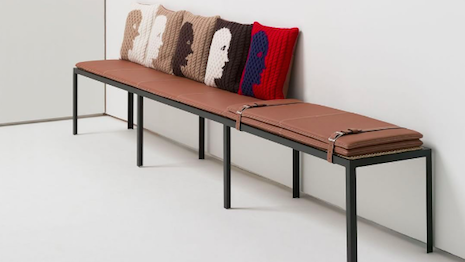The luxury interior design and homeware sector is being disrupted as more fashion brands increasingly step into the rapidly-growing category.
According to Fashionbi’s new “Design Meets Fashion” report, North America and Europe are dominating the luxury furniture market, which is increasing at a compound annual growth rate of 4.65 percent. Among the current trends driving the market are environmentally-friendly materials, multifunctional furniture and branded housewares, including collaborations between fashion labels and interior labels.
“I think collaboration with a noticeable designer can help [traditional brands] to stay relevant for the market,” said Yana Bushmeleva, chief operating officer of Fashionbi, Milan. “The brand identity is crucial and the key elements should be recognizable.”
Crafted collaborations
Fashion labels including Gucci, Versace and Fendi are hoping to make an impact in affluents' homes with their furniture offerings. Most upscale home collections offered by luxury fashion brands include pieces priced around $11,000, or 10,000 euros at current exchange.
Last year, Spanish leather goods and apparel house Loewe premiered its first home furnishings collection, which spans furniture and decor with a focus on craft. Following a debut during Milan’s Salone del Mobile home fair, Loewe’s “This Is Home” collection traveled to department store Liberty London for a three-week pop-up.

Loewe This Is Home collection. Image credit: Loewe
Leveraging Loewe’s leather skills, the collection includes items such as laser-cut lampshades and chairs and benches lined in leather. Consumers can also purchase a stack of multicolored leather sheets to embellish pieces from the collection or use for another decorative purpose (see story).
Italian fashion label Gucci similarly branched out into interior furnishing items in 2017, under the guidance of artistic director Alessandro Michele. Rather than establishing a separate space for these décor items in Gucci stores, the pieces are merchandised throughout the boutiques, driving home the idea that this line is one with Gucci's fashions.
This line brings the codes, patterns and motifs that Mr. Michele has established at the house to a new category, ranging from furniture, furnishings and crockery (see story).
In the home decor world, trade shows and design weeks have only grown in importance as they have become prime opportunities for luxury fashion labels to launch new collaborative projects.
The most prestigious furniture fairs include Maison et Objet in Paris, the London Design Fair, New York's International Contemporary Furniture Fair and Salone del Mobile in Milan.
Since Salone del Mobile’s launch in 1961 as a small fair focused on Italian furniture, the event has grown to be a global phenomenon with major brands from around the world gathering in Milan to showcase their designs. The show is a centerpiece of Milan Design Week, which sees a plethora of launches, parties and events.
Iconic Italian brand Versace was also present at the show, unveiling a new home collection inspired by the legendary Versace home located right in Milan on Via Gesù (see story).
Although luxury fashion brands have been dominating the furniture scene, premium automakers are also making special appearances at design weeks.

Bentley Home is a partnership between Bentley and Club House Italia, the artisan furniture designer. Image credit: Bentley Motors
This past spring, Bentley Motors showcased its licensed home collection at Milan Design Week, with the centerpiece of its exhibition being the Buxton kitchen. Bentley's designs are inspired by the brand’s heritage as a luxury automaker.
In partnership with photography tool manufacturer Leica Camera, Rolls-Royce spotlighted the team members behind its new Cullinan SUV as the subjects for a photo exhibit at this year’s London Craft Week. Rolls-Royce believed that Craft Week was a fitting event to exhibit its craftsmanship, as the brand strives for quality and authenticity (see story).
Investment and innovation
Since the luxury furniture market was valued at an estimated $23.1 billion in 2017, brands are taking this time to further invest in their home furnishings.
Italian fashion house Fendi gave its home furnishings their own retail environment with the opening of its first Fendi Casa flagship.
The dedicated Fendi Casa boutique is located on Milan’s via Montenapoleone nearby to Fendi’s fashion boutique. Opened to coincide with Salone del Mobile, the 4,300-square-foot store allows Fendi to showcase its brand story through a different product category.
Within this store, Fendi Casa is highlighting some of its creative collaborations, including Toan Nguyen and Marco Costanzi. The boutique is situated in the Palazzo Carcassola Grandi, a 16th-century palace, which has period architectural details such as frescos and inlaid wood ceilings (see story).
Not all luxury brands are focusing on large-scale furniture, with some opting for smaller and more accessible pieces instead.
In a bid to modernize its product offerings, Tiffany selected Reed Krakoff to design its new gifts, home and accessories collection for 2017 (see story). Tiffany Blue and silver are prominently featured throughout the jeweler’s home offerings, and the flatware is used at the brand’s Blue Box Cafe.
More brands are also harnessing technology to enhance customer experiences as affluents design and update their personal spaces.
Gucci is using mobile technology to help consumers decorate their spaces with items from its newest homeware collection. With the Gucci mobile application, users can use an augmented reality feature to virtually personalize their space with pieces from the new Gucci Décor collection.
When users open the Décor section of the app, they are prompted to “get ready to decorate.” The app detects a surface, and then users can select a product and digitally place it in their home (see story).
“Technology is penetrating also the design field,” Ms. Bushmeleva said. “For instance, H&M announced a new service ‘H&M Home Stylist’ a unique voice assistant, with the ability to give styling advice, creating mood boards and 'talking' with customers using Google Assistant technology."
{"ct":"W\/GIFXz1wbvLBEmzDUUiPP3YEI1yY5WfaD3BrsMoaf4AdnfyPA2wFpy8q1hCTRhVGA1Tk\/qqQzwvMl6yGIKJkeF0EDXC12s4C4HEKOrwVMipKwNuyA2Xgq8P\/cIShNRgYcVHg4aLqDCYggG45ybcTI5l58u+1NtbYlV1CwS26tYQUxNLH0qrgHanZnUEflYPl6PpDXerXrNjh26dY3cEfNh0kRlqG5EidzbqGHM\/0pTsrMA0\/Y\/SGURoN7j5HuZAwcFvF6N+JBHPO8ow+WVTSFydbZPrFBxrDRmLV1qRm3IzICwCxoyebD+Ym3fcxp1AY166EU+eFb61Jc0CWBEpQvetPEWLTwG1219gDB2sgFDYlv1Hu82zA+UN4ZEOzOYdc4C9QpJVAR4kO+aQMSXeN3\/DYUYBXM9CqZWio3Jnm6U5ffU\/oiqx6ouMJ20l8JCVp01aUDnrmA0FmOvLFlOHr59MA2PXjqEo2vShcG15XBnjjg56XXWSKAbQxKpuJoiQm7FuNx0C6iF9QqnaKNIbdERbZ5Llc+UoOLt2NbY1q4svUdVVfVlabqMJWGX70FTic7CZ9GmY9LLf0mbCXeHAGqqpGCB\/p0GnD\/xHy\/WuZixAzC9h5sko4eCq5qt2X\/LfTfMyTQa\/xz2N6PHkPcXd3oul7q3aZSQLfrY5QqjtB4mG2K989fX4yFWMXCWs8Pl6e+lU5qC+B2+zQGeKL8BC7DO10YL\/Z96TBpCa6SkfyYB0f82iDOUz57KQecFCePeiQGAI6AD3DQV\/y\/dGjgliGynGfv0WwrVSL7ewMw946HX7\/L9cA3MHGVshxdCumuP0wuOQi1HcSJGENwyDrgW31eO2FcAwJoeqZaFBWpCnc6v1xOGeCuFgZ0A+Gj\/mWcunemTIb11r9BQvg\/hARAwY9sfWlY3BmDWkZupKEsdwjCMVC6XOx8QEJkzLK11EENJ09Qc1YLe6aeGdhNEHwlyqXp+tU7S8x2ogIHzBOA0u+c+3QbCH\/Ra3yN\/uXOKpPGucVO1zllt9IDO0ug3kJbIXzL1yVfqgbL6cId+IQAVDk\/PpuFloYDcn7URAXldI\/FeJpcEdlsa4OQDbvkrD37Y4iLftEmLcTuO95Drl0feObhoFPznsxw6zrHJtxpGrpxU5s9FjpV3pA2hVRuWYztbqOs00d4Uami3CKUeVp15TKkXvIRJAxHGNl81wvTdRgx8Gr78mk6MaMtixOr\/m4xew\/10IWIVxH5AbN05sOf4OCJFuGWQGjQiBVXPsHDaCGQB2uCBIN9a8MUYI2sThqRgeFcALqco98merzTTriFkpr46llyGE3FWh6\/EH2eBYIqmMqSaMesW11ZPwOwm6cl8NhpUsykfdKjwXGu3qzQ2IXh7oVQZv5FFaUJmB\/Sp3adILbHobo6YVU5E7rLL3Dc0IOTj5OzdHCexDFteTyMKsX4BUyoz2U1hwhDGJ2Ccv6AC1twyaayICMRi0hBJYeuf4DHFUHszYpJllinx55\/tI4g40j+XtdKTaR9XboqpSMEaWjTr\/9xOzjsOS+ObYdvLJ9lwzRoTdGZXs57OTqDosUzVBqaKn2DkCi6jPf8SWMomrTEAdrvqo72+rEa3e3Lmn2OhofcDZ3wEB4anCsxwoI+B01kFMGK4Gghty55nRTJaqWLeFPunxpBZXC8uCjbf33BRubG5Qvhz4lbM5rbWjKS0ZgB2PnjIZjBDGv6DUtpLxwwpq\/63L0GrC91MekQWlKyXkjqYaP5m2xInZYQOerlwEf2htn1dWY0HLaY3qBmy+3ebyTOhW+m77lR54D\/NfOROppnC554JvidGMVQFdgjSAs6p0nel5A9V\/CkdYK2cpmJCaflicBqv+5oxkOjrtNYS+pagfjCWVbgnUICgIUAjOe6ofywqrfNCaPEaC\/\/Gcp4\/oG2bVO0pm\/xodB5eC1jRwTgKdu3glODlVjr8qf0NpEsBeBsHV9w3sjnpMmB43rlK1Mcjxiv8xL0jOstb0qAzX\/xmplGHDHd0INwGXaBDGcsfYhwBaf1w0QZ+OQDDgS5f4V4Pz\/ZAD7yAgZrqFjvSgTXRm1sfAcwnO2iZbCUqL9Lx8x5JQMlM3ZnkulbhaMR+D2MNYn2iJRuI63RuR0nHATy4sSE+ePQBlyxm6npDAIDvYh61kocUEYmt9HReImyLLV3iH7\/2IcB7EGM8rrs03diI0+gksI8BIIRBnosA4w7OgqWG6qnV\/3pV3CH859U4xi4qwPhbJ2B7rMX600Uxaje3dPYbaHr9QhiJDEdhracDa\/cX8nL5vR4fZZCzJt4EYUMai4bNgCwDNxFw36H+qv9UOK\/xjmak\/ZK+XpZjYjQEl5syM1zuCcSYTPHJT17u3AuhDALJaOWkLTxNmnsEWBriIbQMFw3iVCcjI79tNJsgi8R0jzQhfXxDWmoMFC7Zhtua+In6wWMtbtkHhLBUY+Yzd0bxsBnHAMvVP0H5Md11vBgEZS0bnmzp9fHW5suonH1HxEd\/HYj\/nzx\/hdK6hgtLMA4AIVUzhpjp3emiFEa5Qz8o1PsXzyPlzaDInwq1nkNr+tqvhkFP\/jTs\/egLnKgOX4aBpNHTCJrZuXs9youR2qiZwIx1AZ\/4vUhA8jMNqC7Djlr4+Q4lsYmmG5W\/\/pUGmBJgxiyVyQTEH2JtQXcYmofQYTH86W06Js8wpMZaBm+Pa6PtnD72lAmaNvhGDnUKmVGVBSV40jPcVp+6UodLPDiog5pkRVBlAP9ML4ZXQCzIftDA20rOT9qCPFkTRYInzNHHxDQvNJSax50k\/x6vAft+p85TJrcy\/qrOWZFYQnwWnSCSGl8MOQ9Z3eCIFxETmt6rBXsNeT7AAvhTHc2bDRo0j3V5bRrLxzRL\/4r+IUqBaG+tev7cl12xp+HYptqdLCeTSFp97p+yB2Ref1WgdogSLOhj5fLHYdAi4gnUTnkO7K4nXEmfuMdbdhJZEpM1bVzQaFVMFi8HLhtb1S8gAJEBsusrx+6LZ3RH46WuGI+Scwly+i\/Ayp\/oEYf7P6I0Jb9EljqDqltqgplcySLnHuWGdP0VCTit6cal9JsK99ZZpxk90\/HqKHmnpIlssaXYILJ\/EIdeqqU2wQvTvFu\/YhN1YYzIH7l48mbLiDE8VW9FC3hJ5xcapaAR19QrGipCDCYM7CsOv3QcGXAo01IwQk\/7ROQ+u\/KLP\/jaXC9\/csvvI7ufC\/cjWTdK29mHvUUCiNV8gFXN09UDzPJ92o+aE8+I32bsZRoczKZ6tEdFECsGTIJdkcVTQ+BQR9AVXPv0pkoNz8E1wVuRSiyeUIEEaAFEaf1Alwcqfliyjhe1P11BlMS+Z45Y9N5ElMGfkAMLJZiJGMsfAyqZvxwro\/vztUjKMYDtWHDxqycrE\/XPPyrmdV+jLatLXn3wlfX1OtLnvdWLFmVwNCpk0K4PpjtJF3zRhS26GhclyWNmq9rDt\/Sqp+ZsxRX9mV+jeUjzaAQKpyAaWKFb6NsWkxgl\/EUIKkQZuuqwVl5sE532rSetYfvhg7KP5MwXOAlXhF3lKms8yH6m5EIPf8bWClAc50P7gS3g0hOJ9PZ610uJTxnE60yetNyiMFCptStIRUZ3maDRj8JJgGRioF5qfhZluRaSuQcxsXeZXnjR8EKQSA1gdBGQr68IsKcCgQdQTTp5KXM2KpAz2rHo9Sc9NDkjZYNx4sohvSIgjhEm6thdajISjk0JL0c\/s5anWRHSz7Y9\/IEtAWyjK2AoT8V7hLKZ4uQPJDUmD2DioZk9ctpf9uwXWXSZjhWjkmyMcpNEJUjlEtR7hTIZ91V9uuQzShZ0p3TYmil1iBuPovRZCHJZnZ9hrpiyqTV0dsf+y4eZZ16OMvbiCM\/NdN9E+rtOEJHOrI97xhgSR0PhuhFfJRW7Buu6zPi10BdeIIhPZ4F4rtuaU9prMR10ZroXrW\/5ytSjbWqhG\/eg4QhXfGxnT6NnrtUytqAjfvyScaWPxt9MvmnTrkN5GfN0lTg1Ezxb4gRiYM9x7B\/wC9Y28VZRRTisSkJWaj03z4oWFwI3a86D69EX7JxNTN7MWw6x8MogDrnXN8n\/PYHNpW+gh91MFRbkP7o1gmW9yCnL4NmRFKOyK41N9B3rxNvHgZNBhzB4D1APyEt\/4Jlxj+Jyo81juQY47\/iacEKdvExSRwq11ISkUVQtqaBP2RowuVp\/ylwMGJTKHzjT8AQS4latYajEFtctrBwpJagHGC3hOQTZH0D0eN42iVEzGyRALHRAfOAudTlRIZuBV2FLbFlf6Ga1uR0PPFJCyVLaxgunlh\/vAZiiNT5hRfAHhAFvS0cpxwCOoz8p4ErBkWRUKZ68o1RqKu+9KqypVq1WP+ICvLOCv\/wW8yUWUNw3ZwTZC47006i9kDoee9wyT0tpP5iV9PGsk7FbvlsW9bQHPzpWX+kl73eYYUW0O5XiR2YRHhQoep+Lu3sUh0zfiUjR+ysvJh9acwTEtGiz5tBiQwr1JK\/YyFb7XeKjFb7BEEF+3eFyjDDIoPY2SF9oPWdFh9\/SF31i5bVpu24S1vwYiHDYuAi8kDmHCJUiQHP1hGI+pHs0\/EIyXNwOgJHV8upH9TQEBf+TPiy67HF6DN2kJA+h1LhUorotwPO3qbPAg1sFfPfIOsyU4ClN0xmup+HCjoe16O2DctlnVs72NQo3dYOGVUz06Lx\/MujsbNddlqai+f1cJbxFHzoG+d2kx5fg2ANbQMR8eKqjHMJu9i7L\/hEiaA1d7sl2HaDClx8mpHro36dDYFXSKDRBBhM\/poUo32k44wJVquK2eDs1lc56LC0Wsr6GvWBSHR37aEQiTZEkPkEpU71aSv8k1ENPT+vZ9xD5j13Xr\/SHiL3NgDziv4Gma6n4IaJtp1739\/WGTn85G3EtDR0D1MswZ3EUQO8ZjwjsFlHPwE4DpyIvlYjcKYBwhvkcmPhA2joFgKckBCmbgx3yk\/+W7wJrkmVQf6KFyXXGMfnRuoH7DztWYpwyFaygSW4Iumw2RuOFFCsLeHaNNp2nFkCRoEV+KL0wZqfDExck9uCCKpV1RuNruqoFhsLoYWxWboe74gQvXGKfRHNj81fJTsAClAf5I99vEBM1xHefn6kSpKk60d88drG4LTrWd4f+Ay+AfrJjOWD0Mtcvm8qUf6cTLjmnjNriaFVCeR7PwpZtb87Oi2+eQKe08joMpoIUtIN4CKDe9Rz4FJ7iXfoNxQYsQ4r6mHoQYU6KOevhNKhLo+rnx0dClQeQmDhZ6\/R29eNCyGQ1cespJ0Jtlm8bomj13scxsoYHRoL\/uFpr+LW1ktm5O1WKTus9Ylh76pThZVA7CYxZjzaTUEiryeIN7ekRDPMndcpHdtOBAXs+A+PVNiPhacW\/ByEq532t1OMxIfSVEKYYAzyzsvpD37v4oiNz1NTL\/PcqYKxLm1y+rGz2ynxz6wVtQYX1iPM0UsUYfAQ71E9nqG0KQ09JZUJ6W2ALytEajISoVA+IzdEdDFiWQFjWbI\/2JS711Dkr2augq7giLtDAPbz0gnQ5nqAO23REF0+YkrT8SIStTVpFpf+iEkvYws4b07790DX5HyZ5IbE83IhiUM\/Nwp5HnuHYz34hMRZUA+jt8kbJUWle14ErZod74SkYJwMDx3ZkOjRtgmlrEh6amVuErUCCm8ybzt5fzAuRv8nOepj4J3a9fPd5eBhckgqj5uK0UskFT9\/oCWfQ\/kVq8vOS7wqZUx63qcazWwP9AfI\/Be9zWyB+WySBOqOAQJA0BcA\/82p\/cJkBInyXRekxZOvpdLVWF2HfE+mKnXk1aQ2Tre48bR38f2+wjUdJLAjyEYsrC0z4BZ6VVvmJxARyGhTkB8kltYGbL7wNPvF+PTHLFplz0p5Rje\/VaOA1kbOvMTDnTaqvb0k5NkwTssnY9hw0ietHBOp9lJ\/csu10rrhxnDnBt+lEscB\/o31Q\/jotc3Pxmhuq4XiwLZ9lThZ7PDbVYl30uPAIA8FL9tQvGICcEU2cfa2fsybZgnJj1SsioAfPdgEVJV8KaJGpALxgB7IN8lSUyPPN3de5DFioVfRuZ\/RIDkmkMVfJ5Ld6znK7lGHViP0siuMa6k6c+1YFDpAr14W0J2QLmWDAALvkmSn+mXqm\/rFAeCqh46svo8DgtcooG7U1TdGQN8CNoLR97NNUTNxs4xDXcqk+ZNAk3MpfvuXb4to+eqtepeX5MEXVB+s2z\/gFD0mu7+RbP7NO6C2jO29ZCCNwyDsgLcA\/Al3QIKR8uypcR1tq4DH0pRif1QOq38CP9hsazBVlJ11Uxv6OgQlO3PjkHf6soQ2sciv3BIMXvabekxf5ThxOeCyW51vA8rPq6yqguxhdsDXqV7ADbWLgTkaaGJqtDL9pvkmsrD+VdG\/KupCsgTZiGSXu3FWOVJ4s4Qys3ZBOHajldy9V4Ab6Ac6eflt7oo8OG7p1a6mEYNkFGFp1W1QGlG9v0E3g6ufsrK7ynaH82HcqUctcvVF2Z6NDmmDr2697FUuJca4T0lwtyYgVj7Ke1zCIEiaLXmTb244Y9c1Gm4TpEGysYjWYBPYpg3ccNuLInMt+jAtVxhXAhT8eIppRNoKQcM3vUuz8W8F65K14dmPSECVYvQZUBHoMc\/ep1OkBcR7Jn18rfIm7PP\/JiEsFMRk8PE7jbhsIXl4O59tZOJL5S7sMOJv+P9pjDEapgXNQ7+MwEQVUypIiAM1mJy5GRXhCx7j4BZxv\/MDf0IQBMKH60kVzttXTmbbn5kWlN2MZGoNjm+rpoM9+gnLtd9OEj5czQp8W3FYvLK19nKI6LcOtMR2rJQt7wNwuNtoKLjDU8BqFfB5TSBmNb\/bjZtQ455D7ZOn6bCjAv6nfs+24V7aKDlXkOOy1odYDhAJbTwfgDo8EyJ\/bCdcxgRrBF3budaObfZzHvqFwLl4RXr\/k6Zl4CLauBaD3WcVilIL75tW9AYTk9eVJshe7SGU95\/RtZ1RIQkl9+TmprSnqIfirF3FjJFTZDllzxbQqxHf3hlB01BMTbXRwbqAILI1E4+WGXW+DGxdiP8Y7a5uhSCxEP06SPonQiIFSnlbjX3+OWX9gaKU6f1V8pg+h53VIjKe2BmxKM8jNwdbGVmB4vBIuogtKFAgjx6zhK3i8A\/gGIecOe93j5C+wJjG+6\/cfdM8Sb\/bkbqsoOPMAPyWf3PW3jzfBrIHATNM5TXw6YCHNuDPJ64D1g5CpwZ6vZynZ\/Jq1DkxMfLjectAw6QED2S4z\/d8Shwe2QrlHU9gPSAcMl99r7oD7lz\/v6Nr\/A1Qa79Z0sEscLHTdfdEr\/qh2oVtDuZmtfUx4prxggmH3ude8FpPQ1RnN8w2CmPNlhQc\/uesg1WKFhoAydQtbl3h56dqQVY9fIMx0Kpwx8iV\/sp4O7c7Fv89otbLJXLO\/ogFv7\/0CFnEGcZ5t7InZgAOynNpJ004iYTMB2NKsFvg9nVdXQ9MFQ1uUlYO8QMibt1P3gL1BqUSQNS4l1tnALRroiXApHM\/1mduQ2zYlOVGSsnx9yNJ0dP3hclG5isTOZNg5xfWhnI3ulwF1pAWAePvBTXs7F2xnmV4NSUldxkfOmQj7iYJU3uj3p1aTx4FDOo+XG325UxrwNrnqWJC2Qa5CrOpT8WYnFBbwx3vupA7lxBVaYVRiM\/4Pl2TwySTU7dqy9OKQR2tbaKu6I7V874lF9hFd9WpMYwh3qWzzMiDRkcQ5WBvFCKwZvvOn9m6PP2GZlvRT36vjH8TUNVcC6DgbKFSFdHsxPs9vhpnVubY5M1e5IxNsARSY8Pe4rOHaU9i0ZwzbCAN2K7LS3nkVHUmGpV7jBQECY4YK2InoKH5arO1LxkMc9\/OvVTqP8OB+o17\/aT+opmZGBcLpMJHd2LNOpehB8be9LpYNKBsUeYs2JiDgeQ\/4PS1iIByM3js2\/6WbWHRmgN6v0CAedm3vVH0bgAtDXfdRp0BEYPteyzkMbiSBBNlxUaKfxQC9akxLcwWkPj1u88kqxDaA748pau+AzaQH655oWKuF5KHlSXTQS8pW\/P\/IzfrF6gnCnko+DN4rnRaQtHpH5I1+ZIKIczzjoVZuEd1pQn43Z26CK5+l+O0P+ECtZPumgq22nJu3dJtcfWKy3FoNDOFL9p9LD5LlXxQajtVcBC5A1SkBlsfz7lBBRkN3s5Vhj8t1P8saJVyYMMvhzgeu8bs5cmcyLC\/mjb08LRo2PODNrXXeIr0uBTH4BPCNkuqZ9pZRJM8vH8cIkyusosSlZVDXQCTy5VGlBuNaiwh2Mi1r+CW+9Vv9Etgn74uv3kBpblOobwDYHSu4yHzXPrLyJtXGf\/lB6wiJ0zhdaslk10\/VH4V+q4PjDFWQWu1o9xxIsByub5oww6f6WtMAl0TYeuYYWjwJORuy9wCXZnFUZGihHGAFfgv729HUatqKs7OwlqXgiLwRdTECTsZSM21au1HkpQ3zusyGTb0vxDF0ycKa7ETUzXX8LA4flrPafT+Zb5sTkcQo2Dgd7mGrmIRMT\/0Z0QhQiJqHfvjdhXw1Rpg3K4YoVmMRsNeYry49SfkB4Lw9fO4PzVxk6gq0oXFkL1bJvid+1D8VbtqXXTYZp1xave+YCW7oYDNLPDGyLti8IN8mAN6ECgXbkFtdwjsi00PvJsn+Ww0tORXvSZgTjbIluZlrzjKx\/1\/gXwO86lmj1YmGjFBwKJkJC6ittocYpT28FuzVz2cbDRf9zSQC7kQuHRE50jbnJST2p5GbAKdlO\/M3ZLiShNvAkJZ3pESOaVA4SAWitg0ctg2U2tmZpUEQ2b38\/HqBN07bj2G9yToJkIff5keoNsIARVhgGiaJdCwM4O7CTtjgYuOGpX3qaN9mbn4oQOXZvRkPcwAxZ+iM8iQCTlDq38bzUhktX5dV3iAsnVmr1vySJxzbUCH1nbbyttE+TbCZ1b45TqLxu7PCjc\/tOMqUF8NB7oZm0UHz1RHUoCx\/nL1meeZOJwke7AxyktwO7FuGLxcHlrf40CxmcnYBvVtu8Bm5IRCoYjV6BZl6FOYsS0MTSnRBbq8z5OAcNkQLnsYOv5r6Uzpm1t0VEdoFH29JV36G432sdvLIU\/yzzKp8JkjYG97rlT1qcEJKzjWUf8K59BNEudYHKN1o2EWyBiMRcpSEhVjNEF6\/rnrt8bXjVxmxzZFIrL9FWDLoJir2akB6lqamnhMrwZXwCN6L8JQscZ3N1uBGtBOvyU+bC7lC\/rORjVIBL987\/rCswlB4XnQpS3yr0R6z3GLBi8jxfx7TlQlsVuauMCB8dMeyz7PtyCy1t35y0azZ6QWG8vwVVMQO\/fbUlsuA\/\/9GQy3Qe9rxEkzKbvoJ0b66Cj5w6+pCJuUblBC\/MGtETcz7xH5t0Wqb2fUiHCDTeE9\/l79wUGtp0SnbJGoXV9+RLy3s2jxL91XLCLkILUJT+6\/e+IbA23sYRgmvHNOTFTSia\/5AzAbX6o+oDK\/A35TX4AHu0cP9QbW0V10GPb5zYZ7zFPJD7EWcd1vyRIi74vn+vXiFxTc3N8jte1nxMuG2SOPQlORjO8eH14RVenKp7QejZ0HusqlJmOH7ggv+YAPhAb2JLvdpnVVzuwoJQXA89MnLVswhA6P3ldt1xgyb+FOzg8cku4hKobIlcSd4wsEbWA8E21760v943a3MTK9QIc7DMfQgVbLUWVrkvc8O\/7+PZQ3dsGt3e+kHXPpcA20\/H2JUWq4aiFK0GlxEhSyzdYccrbx2jyVegusIyrFbqGL9wjzt+Iuz4Na9RGuhQW1EOtMSJCB9mxODdYps8mga0\/4zbqIJlKkFlGwYtemEHXAkNma941lDoayBkooep9ezIEUkcopMSUHACA7OpxpjYMTRUcjoaUKN+4eWNlS4Gi8XvPZ57g\/tzHs7khMXi1XYHujawtAZSnWo4cwe1l3OfYqZAIoVYmDKEiIQSg+BR\/NMwv8MSy70aykjlsyhv6b+vncdrCKyJ0BVHfI2\/JLhGYfQn6OLXyRLyqBU7BZbVVJL1ihgXzFfKcYj2fn2Okc5uScTTklE7KKE+T9qFnudmppjegRDCvJ4ECQV0jPE2KXWtBcZX1fkzzmn4ubreiA89dD9TgxUEPDuXPf0FaRc4s+GJZ3374keKhw09tUBxN6jxCyX7h9nVgKLX+FQ+dUp5Z6RWQLk3LNQ7skMImeBR5rAoYnaagpNL8DgAzb8K7tTxa541dgbNWdaqelY+Re3WuVOTM+2dJOGT+bnnmKDd8fPWqi+3FRYut1PdaKaYtD4DksF8kRahe7maUinAwmx9igfC+b4ApvoYeA2Y1MpudhbYG\/LVbaK7fHq6nz\/i2DEOkGAhBSTQ6+SSJ61L93VgMCOaMxG1xcpQ7e0tdDCkBjnIFLHMXEY9LGBXuFQLySW9OOXFWsDgtRXXoKJVOdGzZOVA4ZxQ6efIg4FohmiKXUeykWYYJPutpU79Vrefvvjhyr27umnPiuBI5JeDNyzNQBAgpdpvyK3RMaje2zWmW9CPqb3czPCgmon0D84bXmqL7AWRAQv51kK0DE5QrOKhdM1hFjhwXnx6J1YmOrItbMEKUxso4KUqb1pKKgD4gSs6wE6FXxZN1VLQwKZ+ZJoWlO4J8OdG7cydc1fV1kixNCUXsto0jJTGhJzHntzE4uENvIAhEzVOssPGy5cpKa\/fhr4H\/mkdJuzMHqfrpdkRPikvgtTihUloDuaMOM6h+Wx2wX4b+LzAGlrGXXYVSgqcr14TQTKzKhaYzxMScX5BuAKD\/aAewHTYlzRUGazr9pKkASpQHMwHlkr9qyn4Yea14fdo8SqnlWgdSU3tE5MNWnyPFjQEBVnPbuRzg3lhHYu2DnsTL2VCPQd6YaVzHk+0DjJEhOMzbOzSUSUtGZytPtzE8dTRXJnqYnfxmQe1W+Vzm1V80QY495kbyNfhmiy1GlEMUy9t\/Sqy3b24pwKZC3z1U3LhPjHgpXH5qnObgnqG2NqmcdmU9c5vvRiC3YwS0nzfVau20oINllZzb0A8euriAL8FlvhqFP0Tc4Ah5epxQyU\/IyfDwywqbvvD6X4gS\/OTv9VWNkSQQrxFdYgBCZjcCCPOquYSK7umTqy+MvBD9zd4OlLeGZuFE7IMes9cSY\/XVwijfIslc20xB1mVT2O89ml02G\/5eu20UnEADu31EZN8JeYRYIwmwyw0KS574H8eQT2KC3BsMYe83WzZUs5tnuKDJLBTzaJT9Xpy2DQajVpgwyzwBlEVyjBgjcDEB+gOOXV0BiLGfDAD\/wW9VFhGgWcof\/YpQHtthg==","iv":"fbc21e5bfd1e713c8c85a6670f1567fb","s":"7b82b3c3c2b7e316"}

 Fendi is giving its home furnishings their own retail environment. Image credit: Fendi Casa
Fendi is giving its home furnishings their own retail environment. Image credit: Fendi Casa